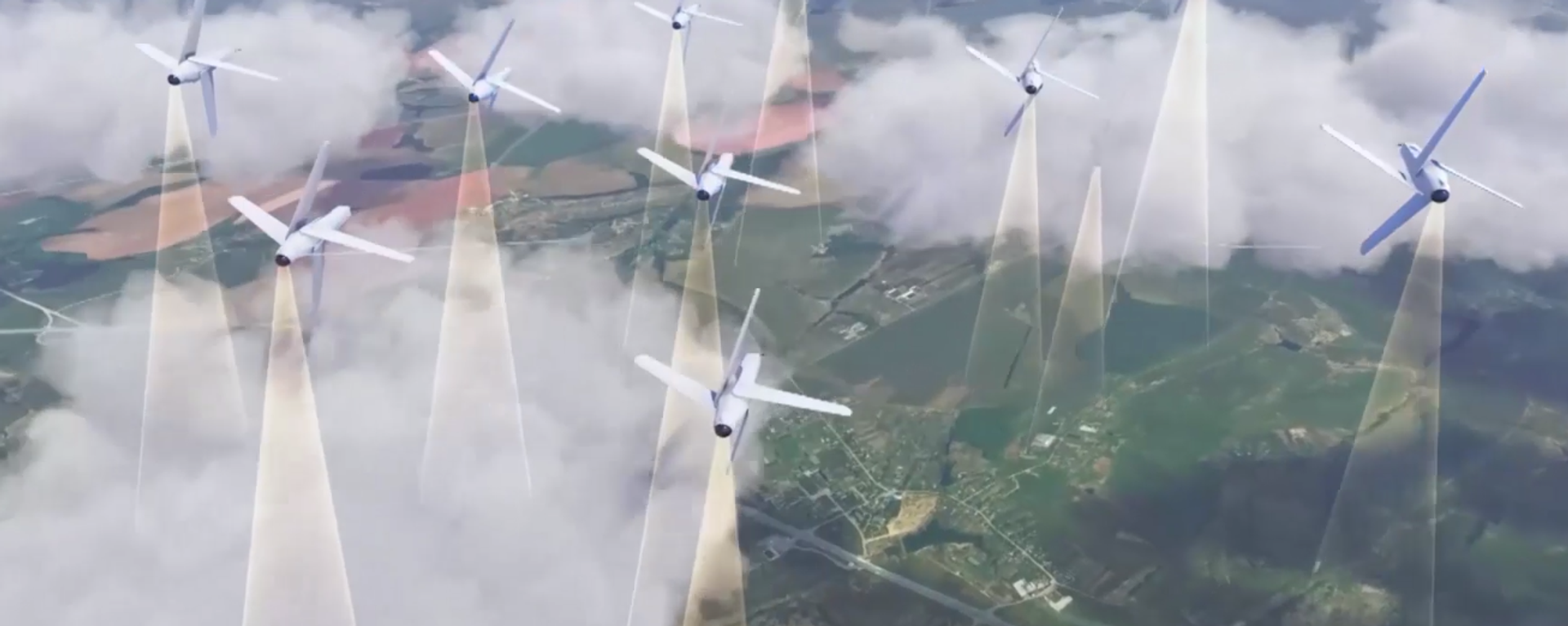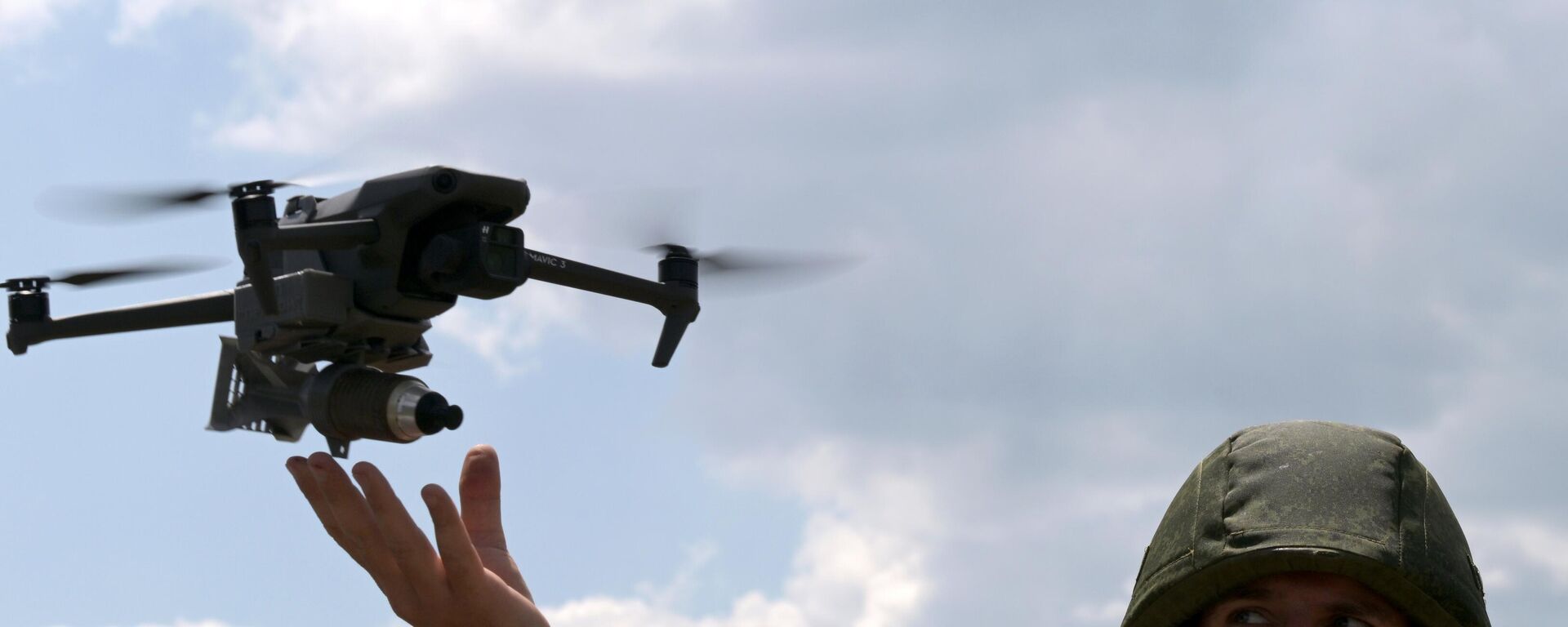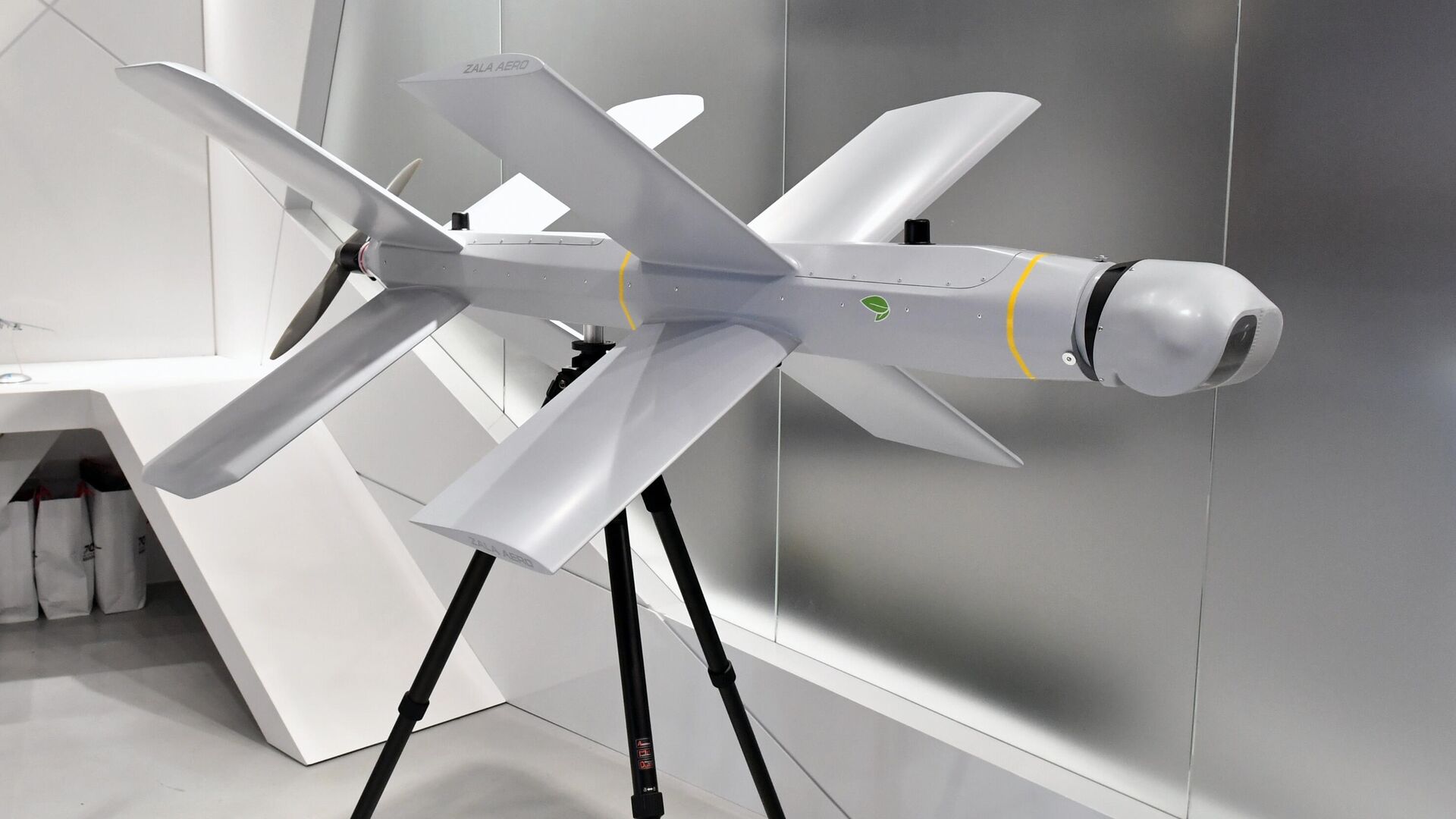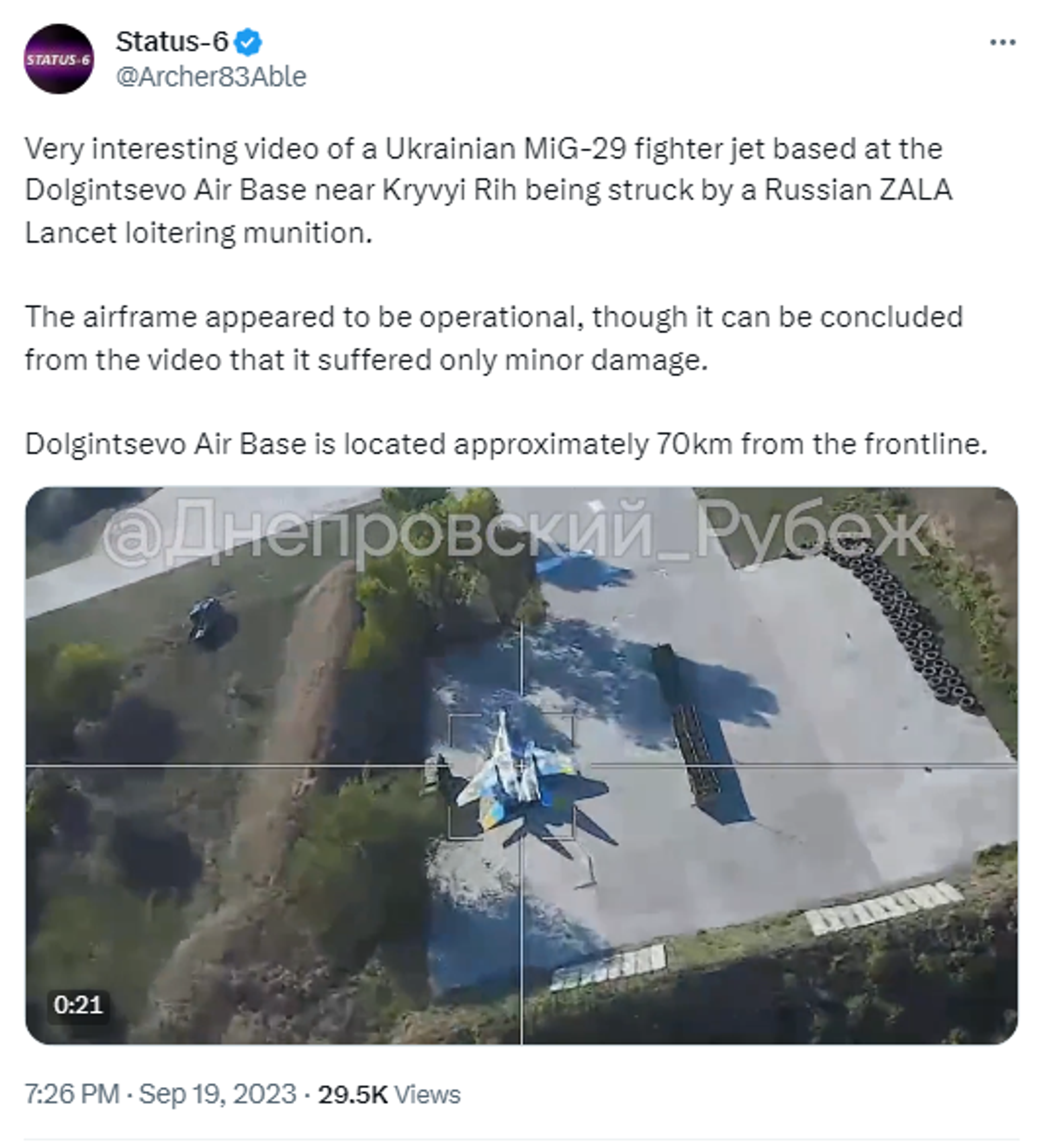https://sputnikglobe.com/20230920/russias-cutting-edge-lancet-kamikaze-drones-put-ukraines-air-bases-in-striking-range-1113514330.html
Russia’s Cutting-Edge Lancet Kamikaze Drones Put Ukraine’s Air Bases in Striking Range
Russia’s Cutting-Edge Lancet Kamikaze Drones Put Ukraine’s Air Bases in Striking Range
Sputnik International
Russia’s next-generation kamikaze drones now boast a much longer-range, which means they can reach Ukraine’s main air bases, said a US report.
2023-09-20T08:38+0000
2023-09-20T08:38+0000
2023-09-20T08:38+0000
military
russia
ukraine crisis
russian ministry of defense
drone
drone strike
drone warfare
https://cdn1.img.sputnikglobe.com/img/07e7/05/03/1110048465_0:172:2956:1835_1920x0_80_0_0_d3b2c5f009a50ae5a107be18c88155d8.jpg
As the Ukrainian Army drags on its futile attempts to break through the Russian defensive lines in a counteroffensive that has wrought huge losses in manpower and equipment for the Zelenksy regime, Kiev’s military is now facing another formidable opponent, a US magazine has revealed. Russia’s next-generation kamikaze drones now boast a much longer-range, emphasized the report, which means they can reach Ukraine’s main air bases.The publication cited footage, posted on the prominent social media platform X (formerly Twitter), showing an explosives-laden Russian drone strike on a Ukrainian MiG-29 fighter jet at Dolgintsevo air base near Krivoy Rog, in the Dnepropetrovsk Region.A second drone was believed to have “observed” the Lancet attack from overhead – a fact that left the author of the report questioning the actions - or lack thereof – of Ukraine's air defenses at the base.What had the author of the report alarmed was that the distance between the air base and the frontline is 45 miles (72 kilometers). Accordingly, the outlet surmised that Russia’s Lancet kamikaze unmanned aerial vehicles (UAVs) are now able to range that far and reach Ukraine’s main air bases. The fact that scores of MiGs and Sukhoi jets sitting on the tarmac could now become easy prey for the longer-range Lancets Russia had developed.The Russian Lancet was touted by the report as one of the most effective, but it was claimed its previous range had not allowed it to reach that far.The report suggested that the allaged strike on the Ukrainian MiG at Dolgintsevo might have been a “debut” of the “new” Lancet - Izdeliye (lit. Product) 53. The outlet even made reference to Sputnik’s own story describing the characteristics of the cutting-edge drones as the “next step in the evolution of the Lancet—and one which, designers hope, will become nearly impossible to stop.”Russian drone manufacturers had unveiled a number of new unmanned aerial vehicles at the Army-2023 International Military Technical Forum, earlier. Among them was the Izdeliye-53, also called Z-53), a next-gen loitering munition developed by ZALA Aero affiliate Aeroscan.Such drones, capable of carrying payloads of up to five kilograms, are designed to fly in groups, and communicate and coordinate with one another to seek out and assign ground-based targets, from enemy anti-air and rocket artillery installations to armor. Unlike current-generation Lancets, launched from a special pneumatic rail, Z-53s are deployed from small, ground-based tubes, similar in configuration to mortars, and are light enough to be carried around – either as tube launchers, or 2x2 batteries, using light vehicles, revealed the promotional video of the UAV by the company.Now, conjectured the US report, the Lancet's new, longer-travel range can “threaten not just the MiGs at Dolgintsevo, but also any Ukrainian warplanes using the reserve base at Voznesensk in Nikolayev Region.”Having ushered in these new Lancets that can cover greater distances, Russia has presented Ukraine with a new dilemma ahead of the arrival of the much-coveted secondhand European F-16s, concluded the report. Denmark and the Netherlands will begin transferring F-16 fighter jets to Ukraine within the upcoming months, following the appropriate training of pilots in the United States, the Pentagon said in August.The report comes as Russia’s Aerospace Forces delivered a strike on the Dolgintsevo airfield on September 11, wiping out two MiG-29 jets and three Su-25 warplanes belonging to Ukraine’s air force, the Russian Defense Ministry said.Moscow has been effectively using drones in the special military operation to cut back unnecessary risks to its troops, while conducting surgical strikes on the enemy. Thus, recently, the Russian Ministry of Defense released footage of airborne troops obliterating Ukrainian tanks with loitering munitions. After reconnaissance drones were first used to spot enemy vehicles, Lancet kamikaze UAVs were used to destroy them.Kamikaze drones (or loitering munitions) are a type of “intelligent” projectile that can loiter by definition, that is, passively wait for its prey before attacking it. These UAVs have built-in warheads and thus don’t survive the attack.
https://sputnikglobe.com/20230816/product-53-what-are-capabilities-of-next-gen-variant-of-russias-lancet-kamikaze-drone-1112639748.html
https://sputnikglobe.com/20230916/watch-russias-lancet-kamikaze-drone-take-out-ukrainian-tank-1113417174.html
https://sputnikglobe.com/20230829/russia-winning-drone-warfare-as-ukraines-counteroffensive-comes-to-standstill-1112966649.html
russia
Sputnik International
feedback@sputniknews.com
+74956456601
MIA „Rossiya Segodnya“
2023
News
en_EN
Sputnik International
feedback@sputniknews.com
+74956456601
MIA „Rossiya Segodnya“
Sputnik International
feedback@sputniknews.com
+74956456601
MIA „Rossiya Segodnya“
russia’s next-generation kamikaze drones, drone warfare, russia's special military operation in ukraine
russia’s next-generation kamikaze drones, drone warfare, russia's special military operation in ukraine
Russia’s Cutting-Edge Lancet Kamikaze Drones Put Ukraine’s Air Bases in Striking Range
State-of-the-art drones capable of performing surgical strikes on the enemy are being used by the Russian military to its great advantage in the special military operation, with the Russian Ministry of Defense recently publishing footage showing airborne troops blasting Ukrainian tanks with “Lancet” loitering munition.
As the Ukrainian Army drags on its futile attempts to break through the Russian defensive lines in a
counteroffensive that has wrought huge losses in manpower and equipment for the Zelenksy regime, Kiev’s military is now facing another formidable opponent, a US magazine has revealed. Russia’s next-generation kamikaze
drones now boast a much longer-range, emphasized the report, which means they can reach Ukraine’s main air bases.
The publication cited footage, posted on the prominent social media platform X (formerly Twitter), showing an explosives-laden Russian drone strike on a Ukrainian MiG-29 fighter jet at Dolgintsevo air base near Krivoy Rog, in the Dnepropetrovsk Region.
A second drone was believed to have “observed” the Lancet attack from overhead – a fact that left the author of the report questioning the actions - or lack thereof – of Ukraine's air defenses at the base.
What had the author of the report alarmed was that the distance between the air base and the frontline is 45 miles (72 kilometers). Accordingly, the outlet surmised that Russia’s
Lancet kamikaze unmanned aerial vehicles (UAVs) are now able to range that far and reach Ukraine’s main air bases. The fact that scores of MiGs and Sukhoi jets sitting on the tarmac could now become easy prey for the longer-range Lancets Russia had developed.
The Russian Lancet was touted by the report as one of the most effective, but it was claimed its previous range had not allowed it to reach that far.
The report suggested that the allaged strike on the Ukrainian MiG at Dolgintsevo might have been a “debut” of the “new” Lancet - Izdeliye (lit. Product) 53. The outlet even made reference to
Sputnik’s own story describing the characteristics of the cutting-edge drones as the “
next step in the evolution of the Lancet—and one which, designers hope, will become nearly impossible to stop.”
Russian drone manufacturers had
unveiled a number of new unmanned aerial vehicles at the Army-2023 International Military Technical Forum, earlier. Among them was the
Izdeliye-53, also called Z-53), a next-gen loitering munition developed by ZALA Aero affiliate Aeroscan.
Such drones, capable of
carrying payloads of up to five kilograms, are designed to fly in groups, and communicate and coordinate with one another to seek out and assign ground-based targets, from enemy anti-air and rocket artillery installations to armor. Unlike current-generation Lancets, launched from a special pneumatic rail, Z-53s are deployed from small, ground-based tubes, similar in configuration to mortars, and are light enough to be carried around – either as
tube launchers, or 2x2 batteries, using light vehicles, revealed the promotional video of the UAV by the company.

16 August 2023, 12:38 GMT
Now, conjectured the US report, the Lancet's new, longer-travel range can “threaten not just the MiGs at Dolgintsevo, but also any Ukrainian warplanes using the reserve base at Voznesensk in Nikolayev Region.”
Having ushered in these new Lancets that can cover greater distances, Russia has presented Ukraine with a new dilemma ahead of the arrival of the much-coveted secondhand European
F-16s, concluded the report. Denmark and the Netherlands will begin transferring F-16 fighter jets to Ukraine within the upcoming months,
following the appropriate training of pilots in the United States, the Pentagon said in August.
The report comes as Russia’s Aerospace Forces delivered a strike on the Dolgintsevo airfield on September 11, wiping out two MiG-29 jets and three Su-25 warplanes belonging to Ukraine’s air force, the Russian Defense Ministry said.

16 September 2023, 10:08 GMT
Moscow has been effectively using drones in the special military operation to cut back unnecessary risks to its troops, while conducting surgical strikes on the enemy. Thus, recently, the Russian Ministry of Defense released footage of airborne troops obliterating Ukrainian tanks with loitering munitions. After reconnaissance drones were first used to spot enemy vehicles, Lancet kamikaze UAVs were used to destroy them.
Kamikaze drones (or loitering munitions) are a type of “intelligent” projectile that can loiter by definition, that is, passively wait for its prey before attacking it. These UAVs have built-in warheads and thus don’t survive the attack.

29 August 2023, 16:15 GMT






